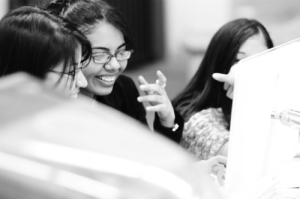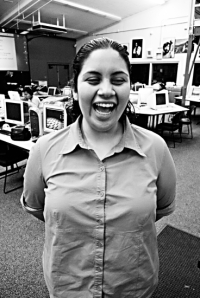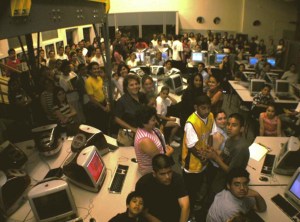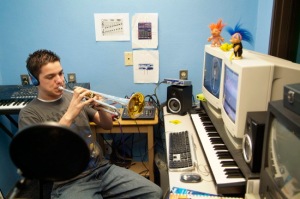https://www.youtube.com/watch?v=lVDFia3T2Ys
This is a video reflection (lessons learned) from 2002 when we built our Community Inspiration Studio (our learning and creating space– AKA, our classroom). Every month, we made a video or a photo essay of what happened in our studio. We posted it and shared it with the world to see. It was part of our process. Here is a video I found in a hard drive that had many of these reflections. I’d like to share this one, in particular with you. As we embark on our journey with our Digital Promise Schools, I look forward to helping them make storytelling a key part of their showcasing process.
Back in 1998, I made a conscious decision to recruit young women into my tech planning and support team. This would later be the most important decision I made as a teacher and as a community advocate!
These young women helped me organize weekend events with parents to help educate (and market) the power of technology and how it WILL BE THE KEY to give our kids and our community access to more options for success. It was a conversation about possibilities, expectations (for all of us), and an opportunity to be proactive about being smart, responsible, and respectful. I made the argument from the start that this journey needed them, and we needed to push ahead with an innovative attitude about learning from that point here on. They believed in this dream: many gave their time after school and on Saturday’s for a couple of years to help visualize it.
Secondly, I made the pitch for the technology plan at San Fernando High to focus on affect thinking, and NOT solely ON TECHNOLOGY! In other words,–asking, “What can you do with it?,” as opposed to simply, “How does it work?”. We made LEVERAGING technology the goal, and then “WHAT IT IS” and “HOW TO USE IT” were by-products. This was key in the “marketing” of our student teams, and what helped make (ultimately) our program into a global model of what learning, learning with technology, and showcasing our stories looks like. This allowed us to create a powerful student-led team that did more than connect cables and reboot machines– they changed the culture of the school, and the quality of life for our community! Empowering girls to support, model, plan, organize, and lead a variety of projects– inside and outside of the community–, had a huge impact on everyone. Consequently, some of the most influential GIRLS AND STEM (STEAM) projects nationally originate from our school’s program and/ team/ projects.
This was embedded in our DNA in 1998, and as you can see in the video from 2002 (above), we made this our foundation. Many girls participated in our school’ student leadership;, however, I saw that girls were non existent in most schools’ tech programs. These programs focused on the technology itself, and it became “male dominate,” , as Marisol says in the video. The curriculum made it this way. It was about programming, fixing, Microsoft office, html. This is important, but I wanted to get to those skills to be byproduct. This worked for me, but it wasn’t easy with the traditional thinkers, however.
We fought for a studio, stage, and a community approach with a CLEAR understanding that technology WILL play an empowering part of giving us learning options, a voice (the girls, the community, and our school program), and a stage to put us on the map. IT WORKED. Companies from all over, as well as other learning institutions, leaned on us for guidance on their technology integration journeys. We even had Caltech system engineers visit us to see how we set up our servers for high-speed interactions. What a sight it was to see several of our lstudents walk around with the system engineers and explain our network to them.
We had to do everything ourselves. From creating an interest, to raising money, to winning over support, to even building our learning spaces. We had little to NO support at all along the way from the school system. I knew I had to have an army of students and their parents to help me get the support needed nationally to make this work. We learned as a team, worked as a team, and ultimately,– we won as a team. The student ownership was clear from the start. I didn’t even have an office in our new space. The students had two. They managed the classroom, which they called the Community Inspiration Studio, The CIS., They cleaned it, updated it, taught parent classes, offered professional development opportunities for teachers, and celebrated their produced stories with the world. For a community like ours with a context of struggle and a history of many social failures, we shined like a Phoenix. Why? Because of the students– my women leaders. Not only were they helping me, they empowered me to ask and fight for a lot more. I look forward to helping our Digital Promise Schools tell their stories on how the connected tablet project gives the students a running start with learning technologies available to them in their tables.
I am so happy to have found this video and share it with you. It’s definitely a victory in my past that came out of many lessons learned, and that started with a clear need to improve our quality of learning in San Fernando. This is our goal at Digital Promise. To address these issues head on, help create opportunities, model possibilities for better inclusion, help remove barriers to necessary connections to better solutions. If you want success, use your best asset:, your students. Recruit young women! They were my natural leaders and the necessary voice to help make a serious change in many people’s thinking about what we needed to be doing. It is our goal at DIgital Promise to make sure we help our schools make the connections to resources like Latinas and Stem (http://www.latinasinstem.com) and DIY Girls (http://www.diygirls.org). Both of these profesional groups have origins in San Fernando High School.
Looking at the video this morning is like looking back at a home video of me planting seeds.
Plant your seeds now.
(November 1998. LA Daily News front page story on what the digital divide really looked like in LA.)




